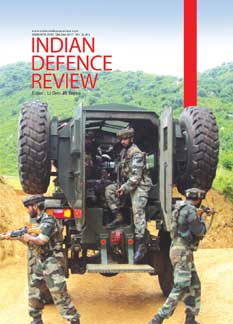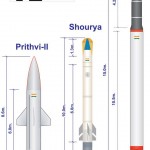Ballistic Missile Defence (BMD)
The concept of having a defensive system against ballistic missiles came into being in the 1950s, wherein both USA and USSR started coming up with elementary BMD systems with mixed results. This process has continued till date with the countermeasures developmental cycle going through numerous crests and troughs. A number of other countries such as France, China, Israel and India have also tried to develop BMD systems albeit with varying success. The idea however is nothing short of trying to hit a ‘bullet with a bullet’.
When, Where and How?
The proponents of BMD have been seized with these questions throughout the history of developing and fielding BMD systems. The ballistic missiles can be countered either in boost, midcourse or terminal phase. This obviously would mean that the encounter happens either in the enemy territory, outer space or over friendly/own air space. The potential kill means include a kinetic kill, use of directed energy weapons, electronic measures and even Special Forces! Each course of action has its own advantages and disadvantages which are not under consideration here.
Major Chink in BMD Shield
In the year 1970, USA fielded the first true Multiple Independently Targeted Re-entry Vehicle (MIRV) payload to be delivered by the Minuteman III ICBM which was meant to defeat the ABM defence shield around Moscow[1]. This eventually led to USSR building her own MIRV payloads resulting in a major shift in the strategic thought process and emergence of the concept of mutually assured destruction as ABM systems could not cope up with the offensive ballistic missiles carrying MIRV payloads. The MIRVs negated the effectiveness of a BMD system as the attacking missile could have multiple warheads (3–12), whereas the interceptor missile had only one warhead per missile. Additionally, decoys may also be used alongside actual warheads to maximise the chances of the actual warheads reaching their targets prior to possible interception. Thus, militarily, as well as economically, BMD systems were unviable in the MIRV context. A viable Anti Ballistic Missile (ABM) defence against MIRVs would therefore require multiple defensive missiles for each offensive one. Although a BMD system that could intercept the incoming ballistic missile before deployment of the MIRVs could potentially overcome this lacuna, it would obviously be technologically challenging and economically prohibitive to field.
The arrival of MIRVs on the scene resulted in the ABM treaty of 1972 meant to prevent an arms race between the USA and USSR which remained in force for the next 30 years till USA withdrew from this treaty in the year 2002.
Multiple Object Kill Vehicle (MOKV)
In the first decade of this century, USA commenced R&D on developing a MOKV (referred to as MKV then) which could be the futuristic ballistic missile killer intended to detect, track, and kill several different incoming enemy missile warheads and decoys with only one counter-missile launch. As the nomenclature suggests, it caters for more than one kill vehicle to be launched from a single booster. The system consists of a carrier platform with on board sensors and a number of small, simple kill projectiles that can be independently targeted, with each projectile weighing approximately 10 pounds[2]. A test of the MOKV was conducted on 2ndDecember, 2008, at the National Hover Test Facility at Edwards Air Force Base, California. In April of 2009, the project was terminated under the Secretary of Defence Robert Gates, but later revitalized in 2015[3].
- Working. Six to eleven MOKV are envisioned to be launched on one booster rocket, which may track the targets using data from the ABM System and its own seeker. The carrier missile dispenses and guides the kill vehicles in the threat envelope using infrared heat-detecting technology to locate threat objects and destroy these kinetically. MOKV is likely to launch on rockets like the U.S. Navy Raytheon SM-3 standard shipboard missile[4].
Advantages
- The MOKV would be a force multiplier for any ABM system. A single interceptor missile equipped with this payload could now tackle the MIRVs, including decoys.
- The many-on-many strategy obviates the need for credible pre-launch intelligence while leveraging the ABM System’s discrimination capability.
- Provides a layered ABM defence against ballistic missiles of all ranges in all phases of flight[5].
- Substantially reduces the interceptor inventory required to defeat an evolving and more capable threat.
Current Status. The development programme was shelved in the year 2009; however the same has been revived as part of the $9,775,608 contract awarded in August 2015, to M/S Raytheon to define an operational MOKV concept[6]. Further, earlier this year a $59.6 million contract was awarded to the Raytheon Missile Systems to enhance the MOKV’s secure communications systems, high sensitivity multi-band sensor, survivable processor, kill vehicle divert and attitude control system, bus sensor and sensor pointing, and the engagement management and a $53.1 million contract to the Lockheed Martin Space Systems, to enhance the MOKV’s gimbaled seeker assembly, integrated avionics assembly, component integration and testing, and an advanced seeker[7]. USA intends to operationally deploy this system in the year 2025-2030 time frame.
Conclusion
The R & D in the field of ballistic missile defence technologies has continued across the globe despite technical setbacks, budgetary constraints and administration/regime changes. Disintegration of USSR signalled the end of cold war and consequent lowering of ballistic missile threat, however, new threats have emerged both for the USA and the rest of the world. While China is competing to be the next super power, North Korea and Pakistan continue to maintain their dubious and dangerous fuzzy logic of employing nuclear weapons. In light of these developments, the BMD issue is again live and contextual and MOKV is an important futuristic component of this defence. Presently, only USA seems to be pursuing this system (there may be other national covert programmes) which could prove to be a game changer for ABM systems.
References
[1] https://en.wikipedia.org/wiki/Multiple_independently_targetable_reentry_vehicle
[2] https://en.wikipedia.org/wiki/Multiple_Kill_Vehicle
[3] http://missiledefenseadvocacy.org/missile-defense-systems-2/future-bmd-systems-2/multiple-kill-vehicle-mkv/
[4] http://www.militaryaerospace.com/articles/2017/04/missile-defense-to-kill-several-warheads-at-once.html
[5] http://www.lockheedmartin.com:80/products/MKV/index.html
[6] https://www.prnewswire.com/news-releases/raytheon-takes-next-step-toward-defining-multi-object-kill-vehicle-concept-300182522.html
[7] http://www.militaryaerospace.com/articles/2017/04/missile-defense-to-kill-several-warheads-at-once.html
Courtesy: http://www.claws.in/1836/multiple-object-kill-vehicle-mokv-sandeep-tyagi.html





